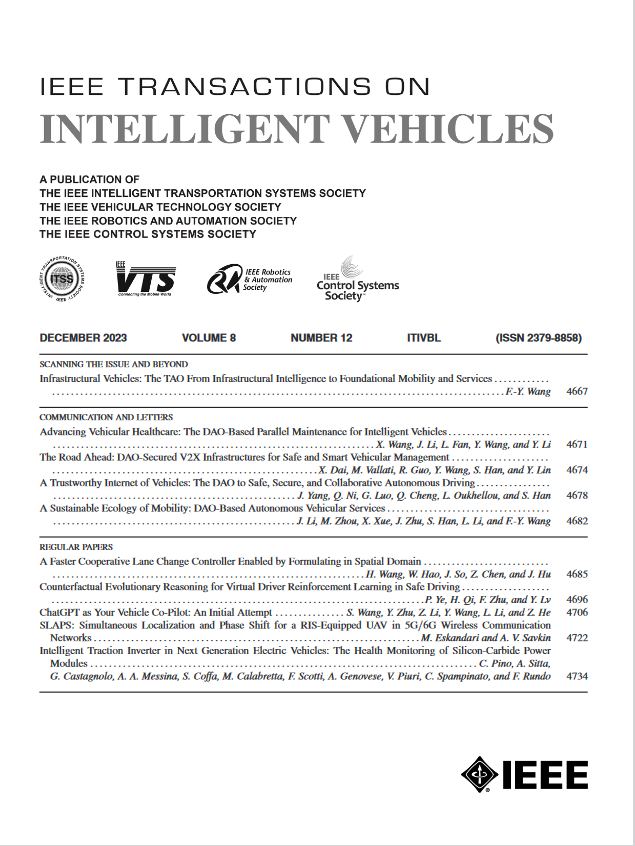基于智能传感器的预防儿童车内中暑的后座监测系统
IF 14
1区 工程技术
Q1 COMPUTER SCIENCE, ARTIFICIAL INTELLIGENCE
引用次数: 0
摘要
本研究介绍了一种创新的汽车儿童后座监控系统,旨在防止因儿童无人看管而导致的中暑事件。该设备集成了传感器、无线连接和智能算法,可以检测和应对潜在风险。内部传感器持续监测诸如占用状态、车内温度和儿童呼吸率等实时因素。采用混合方法来提高精度,利用力感电阻(FSR)传感器进行存在和呼吸检测,以及运动传感器进行运动跟踪。智能算法处理数据以识别关键情况并激活预防措施。数据通过移动应用程序传输,以便向护理人员发出即时警报。该系统采用简化频率分析(SFA)进行快速处理,在低成本微控制器(MC)上比传统方法快80倍,这使其成为实时应用的理想选择。测试结果证实了它在实时占用检测和呼吸监测方面的高准确性,并根据需要触发警报。该系统符合严格的汽车行业温度和功率要求标准,确保在极端环境下实现最佳功能和能源效率。最小待机电流为104 $\mu$ a,能够承受从- 40 $^{\circ}$C到+85 $^{\circ}$C的温度,这项技术有可能拯救生命,并将儿童中暑预防建立为标准的车辆功能。本文章由计算机程序翻译,如有差异,请以英文原文为准。
An Intelligent Sensor-Based Back Seat Monitoring System for Preventing Pediatric Vehicular Heatstroke
This research introduces an innovative automotive child back seat monitoring system aimed at preventing heatstroke incidents associated with leaving children unattended in vehicles. The device integrates sensors, wireless connectivity, and intelligent algorithms to detect and respond to potential risks. Internal sensors continuously monitor factors such as occupancy status, in-vehicle temperature, and the child's respiration rate in real-time. A hybrid approach is adopted for enhanced accuracy, utilizing Force Sensing Resistor (FSR) sensors for presence and breathing detection, along with motion sensors for movement tracking. Intelligent algorithms process the data to identify critical conditions and activate preventive measures. Data is transmitted through a mobile application for immediate alerts to caregivers. The system incorporates a Simplified Frequency Analysis (SFA) for rapid processing, surpassing conventional methods by up to 80 times faster on a low-cost Microcontroller (MC), which makes it ideal for real-time applications. Testing results confirm its high accuracy in real-time occupancy detection and breath monitoring, triggering alerts as needed. The proposed system meets rigorous automotive industry standards for temperature and power requirements, ensuring optimal functionality and energy efficiency in extreme environments. With a minimal standby current of 104 $\mu$ $^{\circ }$ $^{\circ }$
求助全文
通过发布文献求助,成功后即可免费获取论文全文。
去求助
来源期刊

IEEE Transactions on Intelligent Vehicles
Mathematics-Control and Optimization
CiteScore
12.10
自引率
13.40%
发文量
177
期刊介绍:
The IEEE Transactions on Intelligent Vehicles (T-IV) is a premier platform for publishing peer-reviewed articles that present innovative research concepts, application results, significant theoretical findings, and application case studies in the field of intelligent vehicles. With a particular emphasis on automated vehicles within roadway environments, T-IV aims to raise awareness of pressing research and application challenges.
Our focus is on providing critical information to the intelligent vehicle community, serving as a dissemination vehicle for IEEE ITS Society members and others interested in learning about the state-of-the-art developments and progress in research and applications related to intelligent vehicles. Join us in advancing knowledge and innovation in this dynamic field.
 求助内容:
求助内容: 应助结果提醒方式:
应助结果提醒方式:


